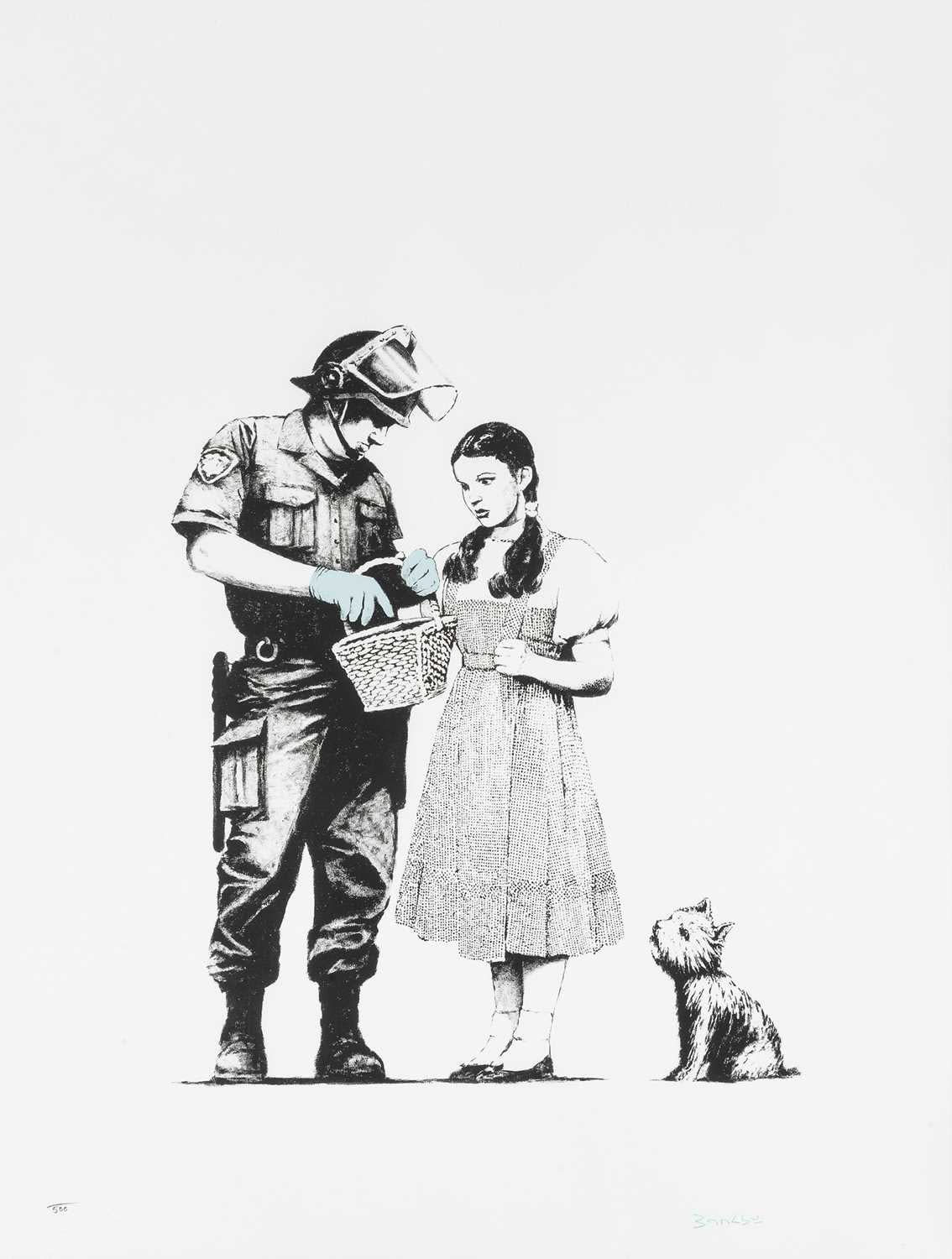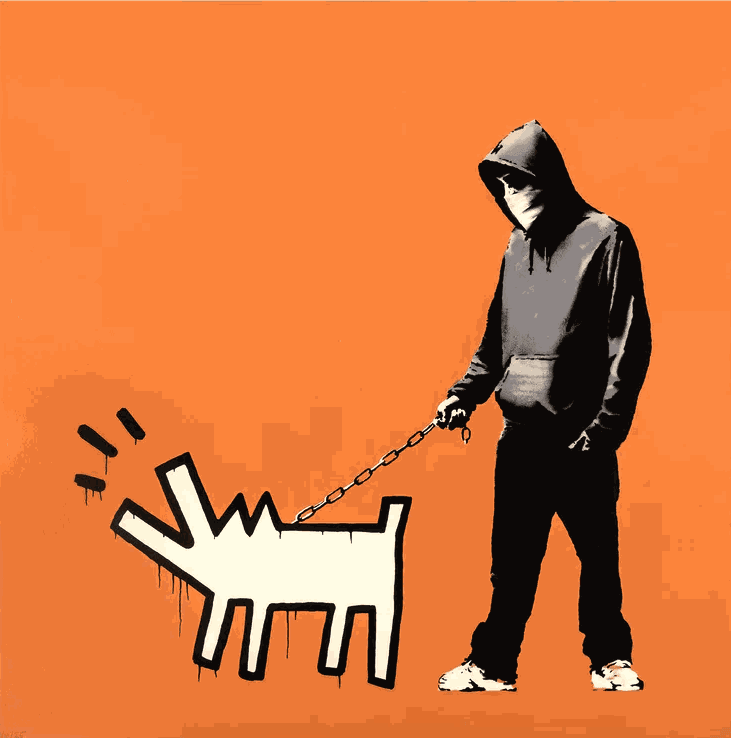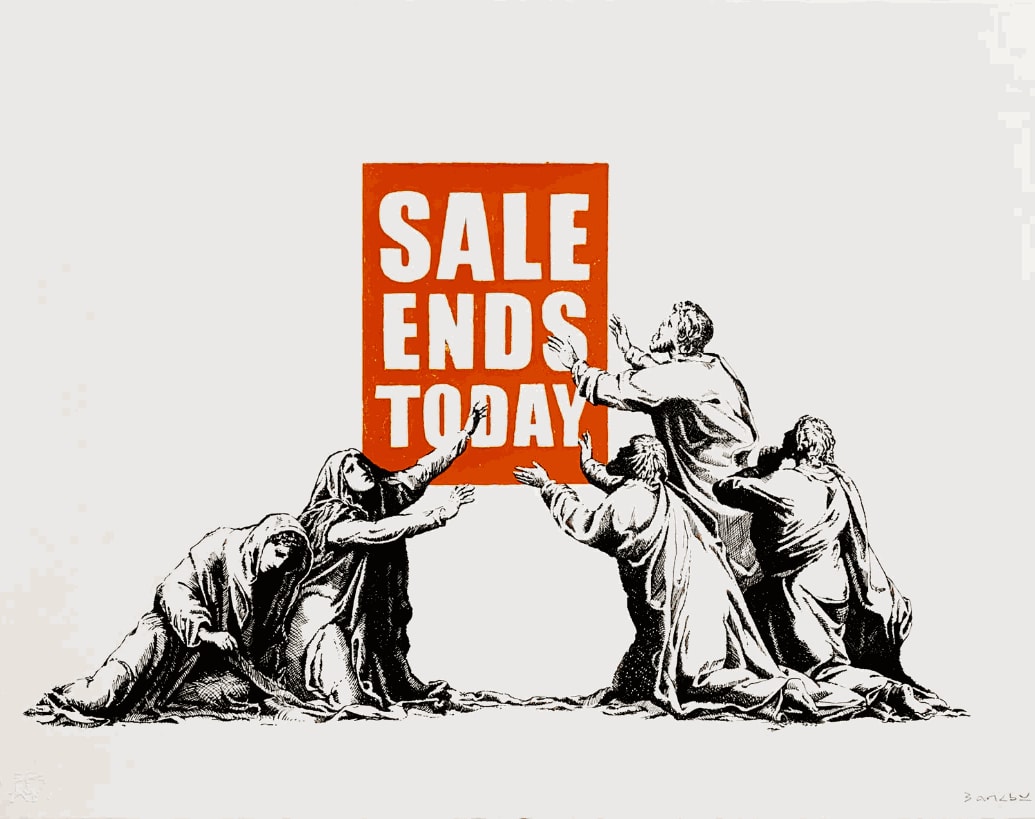
NOLA white rain, showcases Banksy's signature stencil work combined with a vivid use of symbolism. It depicts a young girl holding an umbrella, but instead of protecting her, the umbrella is the source of the rain pouring down on her. The rain that would typically fall from the sky is coming from the umbrella itself, hinting at a deeper theme of trust being misplaced or turned against oneself. Banksy's exploration of irony and emotional conflict in NOLA is widely interpreted as a critique of institutional safety measures that ultimately cause more harm than good. The simplicity of the image conveys a haunting message that lingers long after viewing.

Stop and Search continues Banksy’s pattern of addressing complex social and political issues. In this work, Banksy juxtaposes the innocence of a small child and the power dynamics of authority by depicting a young girl patting down a soldier. This role reversal challenges viewers' expectations of security, authority, and the notion of who controls whom. The piece serves as a satirical commentary on governmental control, surveillance, and civil liberties in the post-9/11 world. With Banksy’s minimalist approach to detail, Stop and Search remains impactful, urging viewers to reflect on the uneven distribution of power in society.

One of Banksy’s most famous works, Girl with Balloon, is iconic in its portrayal of loss, hope, and fleeting moments. It features a young girl reaching out for a heart-shaped balloon floating away from her grasp. The starkness of the black and white figure against a brightly colored red balloon creates a sharp contrast that highlights the emotional depth of the work. While some interpret the balloon as a symbol of innocence lost, others see it as a beacon of hope, suggesting that what is out of reach is not necessarily gone forever. The ambiguity of Girl with Balloon allows it to resonate on multiple emotional levels.

Trolley Hunters takes a darker, more satirical approach to contemporary consumerism. In this piece, Banksy portrays three primitive hunters holding spears, crouching in the grass, but instead of targeting wildlife, they appear to be hunting a group of shopping carts. Through this absurd imagery, Banksy mocks modern humanity’s obsessive relationship with consumer goods, calling into question the values of society. The juxtaposition of a primal survival instinct with a modern, unnecessary object is Banksy’s way of commenting on how far humanity has strayed from its original needs and desires, driven by consumerism rather than sustenance.

Choose Your Weapon is another powerful social commentary, focusing on the idea of rebellion and control in society. The image of a figure holding a leash attached to a cartoon-like dog that resembles Keith Haring’s iconic barking dog emphasizes the tension between authority and expression. The bold use of dark orange serves as an arresting background, further intensifying the artwork’s aggressive stance. Banksy seems to draw attention to how society often suppresses individual agency and freedom, with the Haring dog symbolizing both a call to action and a reflection of the commodification of rebellion itself.

Sale Ends Today provides one of Banksy’s more biting critiques of the art world and consumer culture. This piece shows a group of desperate, praying figures crouching beneath a banner that reads "Sale Ends Today" in bold red letters. The exaggerated reverence for the idea of a sale is Banksy’s direct jab at consumer culture’s glorification of scarcity and urgency. Through this exaggerated scene, the piece critiques not only the fashion world but also the art market, where value is often dictated by artificial scarcity and economic incentives. The stark juxtaposition between the spiritual reverence of the figures and the mundane commercialism of the sale sign embodies Banksy's mastery of satire.
Each of these works speaks to Banksy’s signature ability to convey powerful social and political messages with seemingly simple imagery. What ties these pieces together is their shared engagement with themes of control, power, and the human condition within consumer-driven societies. From authority critiques in Stop and Search to reflections on consumerism in Trolley Hunters and Sale Ends Today, Banksy remains consistent in delivering potent visual critiques.
Together, these pieces form a compelling collection that resonates both within the gallery space and beyond. Banksy’s art forces the viewer to question societal norms and values while simultaneously appealing to the aesthetic sensibilities of both casual observers and critical thinkers alike.
Discover Banksy original art for sale and contact info@guyhepner.com for current availabilities. Looking to sell Banksy works? We can help. Find out how to sell Banksy prints with confidence at Guy Hepner.

